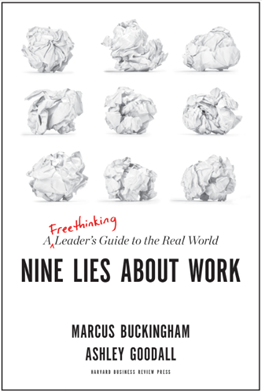
We’re quickly approaching the end of summer, that bittersweet time when golf professionals who’ve been working nonstop start to feel conflicted. On one hand, there’s disappointment that summer is coming to a close. On the other, there’s relief that the busiest season is nearly behind us. (It’s true!) And with good reason.
This time of year also signals the start of budget season for many of us. That means reviewing what went well, identifying areas for improvement, planning for next season, and reflecting on our careers, and the teams we lead (or the teams we are part of). In that context, our ninth article in the Leadership in Hospitality (in the Golf Industry) series will focus on moving beyond simplistic views of goal setting. As with the rest of the series, we’ll draw inspiration from the insights and writings of Marcus Buckingham and colleagues.
Book Recommendation: Nine Lies About Work: A Freethinking Leader’s Guide to the Real World by Marcus Buckingham and Ashley Goodall.
Some key excerpts from the book about goal setting “popped off the page” for me, including: “In fact, goals help you manifest your values. They are your best mechanism for taking what’s inside of you and bringing it out where you and others can see it, and where you and they can benefit from it. Your goals define the dent you want to make in the world.”
Takeaway 1: Goals are a good thing—but most often when they are personal and challenging, developed from within and rooted in ownership and fueled by belief.
Here’s another excerpt that further clarifies it: “…the only criterion for what makes a good goal is that the person working toward it must set it for him- or herself, voluntarily. The only way a goal has any use at all is if it comes out of you as an expression of what you deem valuable. It doesn’t have to be SMART…It doesn’t need to contain key performance indicators or be built from objectives and key results. If a goal is going to be useful, if it is going to help you contribute more, then the only criterion is that you must set it for yourself, voluntarily. Any goal imposed upon you from above is an un-goal.”
Takeaway 2: Buckingham and Goodall infer that voluntary goals are the only useful goals: A good goal is voluntarily set by a person as an expression of what they value. Goals imposed by others (“un-goals”) do not have the same power to motivate and energize and they rarely drive employee engagement.
Takeaway 3: Goals are an expression of values: goals are the best way for individuals to manifest their internal values externally.
Takeaway 4: A useful goal must originate from a person’s sense of what they deem valuable. If the club/company goal is an un-goal for them, it very likely won’t drive engagement and/or have its intended outcome.
“This doesn’t mean, though, that there is nothing we should cascade in our organizations. Since goals, done properly, are only and always an expression of what a person finds most meaningful, then to create alignment in our company we should do everything we can to ensure that everyone in the company understands what matters most. And so the truth: The best companies don’t cascade goals; the best companies cascade meaning.”
Takeaway 3: The last part is so powerful—“cascade the meaning.” The best way for us as leaders to create alignment in our organization is to cascade meaning and purpose, not goals. (If not a leader per se, you can still be part of bringing this to the forefront as an engaged team member too.) Buckingham and Goodall seem to state that imposing goals from the top down is a form of control, whereas cascading meaning is a release mechanism that empowers people to align their work with what they find most important. Meaning at your facility might be expressed as:
- This is who we want to be as an operation
- This is who we want to be as a golf club, country club or golf facility and everything we do should “back up that identity”
- We want to be recognized as having a service standard that feels like _______________________.
- We are a team that wants to focus on delivering ___________________________ for our guests/members.
For next season’s planning, including any strategic, business or service team considerations, it would seem these questions or statements above should be reviewed as one would look into a mirror. This is who we want to be as a Club or as a Golf Ops Service team: _______________________. Based on that statement, how are we doing to live out that identity and more importantly, what can we do now to ensure we can do it next season when we need to be who we say we are?
“The best leaders realize that their people are wise, that they do not need to be coerced into alignment through yearly goal setting. These leaders strive instead to bring to life for their people the meaning and purpose of their work, the missions and contributions and methods that truly matter. These leaders know that in a team infused with such meaning, each person will be smart enough and driven enough to set goals voluntarily that manifest that meaning.”
Takeaway 4: If as a leader, we don’t feel that our team members are wise enough to first set meaningful goals for themselves, and then secondly, to get after doing the right things that will drive completion of those goals, there may be a bigger question. Have we attracted the right people to the right mission or identity? Or did we not have the right meaning externally that would attract the right people that we are actually looking for? (Versus just people doing a job or set of tasks for a paycheck.)
“It is shared meaning that creates alignment, and this alignment is emergent, not coerced. Whereas cascaded goals are a control mechanism, cascaded meaning is a release mechanism. It brings to life the context within which everyone works, but it leaves the locus of control — for choosing, deciding, prioritizing, goal setting — where it truly resides, and where understanding of the world and the ability to do something about it intersect: with the team member.”
Takeaway 5: Love that statement: The goal is to build “alignment that is emergent, not forced.” What does that actually mean or look like? Here’s a guess:
- Coerced alignment is fragile, inefficient and doesn’t drive engagement. When the chips are down and/or the tanks are empty, buy-in (engagement) suffers badly. Imposed goals only drive compliance, not investment.
- Emergent alignment is attractive, powerful and authentic. These kinds of teams attract more great people who buy-in to the vision, plan, why, brand, etc. They also have team members who recruit other like-minded people who will fit the team culture and vet out those who won’t make it.
- As a leader, this is a dream scenario that can only be achieved by focusing on communicating a clear and detailed purpose—the why behind the work—in order to build a shared sense of meaning. This naturally leads team members to set their own goals that manifest that purpose, creating a more robust and sustainable alignment.
Takeaway 6: As a leader of a facility, a department or a crew, I hope you’ll take steps to do the following for next season’s plans:
- Focus on the “why,” not the “what” and work hard to build that understanding of the meaning behind why you want to do X vs just “here’s the plan.” Giving your team a strong sense of “which hill we’re trying to take,” and why it is meaningful is key.
- Empower your team members: give them the context and rationale they need to drive their own actions and the goals that come from it. Help them understand and feel how you are cascading meaning and moving the locus of control from the leader’s control to the team members. Let those who are closest to the work (e.g. the front line service areas) make decisions and set priorities while double checking their meaning. This is where understanding of the world and the ability to act intersect most effectively.
Thank you for taking the time to read the takeaways I got from Marcus Buckingham and his thoughts on the value of good goals, what makes them meaningful and how goals can become un-goals. If you did get some takeaways from this that are worth noting, I would love to connect with you to learn more about it. As always, I would enjoy connecting with you when you have time to talk about the context of your situation and how we can work together to help you apply these principles in your career in a win-win way at your facility. Check out my calendar booking link below to find a time that works for you.

Monte Koch, PGA Certified Professional, CIC
[email protected] | 206.335.5260
PGA of America | PGA Career Services | Career Coach & Consultant
Certified Interview Coach | Certified Predictive Index Practitioner
Based in South King County, WA